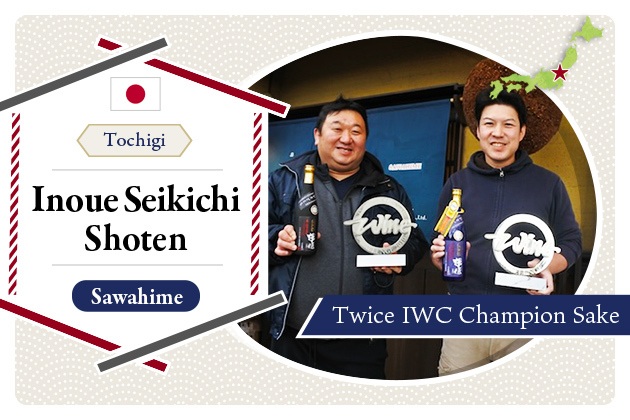
2019.01
18
How is Japanese sake made?
Most people know that sake is made from rice and water but what about the actual process? When you know how sake is made, you will be able to better enjoy it as you have an increased appreciation for the various methods to get it to taste the way it does.
The exact process of brewing sake differs from brewery to brewery but I will illustrate here the general process.
Preparing the rice
Polishing
When the rice is first harvested, it contains vitamins, proteins, fats and other substances in its outer coating. These can cause the yeast to over ferment later in the process, ruining the taste and aroma of the sake. Therefore it is important to polish the outer layer using a machine like the one below.
Washing
This stage is to remove any rice bran or fragments from the polished rice. Particular attention is needed as the rice will absorb water which will have an effect on the taste of the sake later.
Soaking
Next, the rice is left to soak to absorb the necessary amount of water. While seemingly simple, the amount of water the rice absorbs can greatly change the quality of the sake. Some brew masters even say that the washing stage is enough to alter the taste of the sake. The time left to soak varies according to the temperature, humidity, climate and many other factors and is measured to the exact second.
Steaming
The rice used in sake is always steamed, not cooked. When steamed, rice has a hard exterior while the inside remains soft. This steaming process plays an important role and has an impact on all of koji, shubo and moromi to follow.
Rice koji production
Koji refers to "moldy rice" which is made by adding Koji-kin (a mold whose scientific name is Aspergillus Oryzae) to the steamed rice from earlier. What koji does is to convert starch found in rice to glucose. This is what will be turned into alcohol later. Koji production normally happens over two days often drenched in sweat in a heated room called a "koji muro", where temperatures reach 35℃. The importance of koji is so much so that a saying exists which loosely translates to, "First koji, second shubo, third produce".
Shubo (yeast starter) production
The purpose of a yeast starter is to cultivate in great quantity the yeast needed for alcohol fermentation and requires the steamed rice and koji from earlier as well as lactic acid. What this huge amount of yeast does is to turn the glucose from the koji production into alcohol. Yeast is in fact very delicate and if microbes or microorganism get mixed in, it will die. However it does have the advantage of being strong against acids and thereby through adding lactic acid to the mix, we are able to get rid of the bad microbes we don’t want (which are weak against acid) while preserving and cultivating just the yeast. This process takes roughly 2-3 weeks.
Moromi production
Moromi is the main fermenting mash containing shubo, koji, steamed rice and water in a "moromi tank". The mix is not thrown in all at once but divided into three parts, usually over four days. The yeast starter is only about 6% of the whole mix. Therefore if mixed in all at once then it creates an environment for microbes to grow as the acidity level drops, endangering the yeast. This is why it is necessary to mix it in over three parts and it is known as the "san dan jikomi" or the three stage prep.
After the "san dan jikomi" the mix is left to ferment from two to four weeks. One factor unique to Japanese sake is that the fermentation of alcohol and saccharification (the process of breaking starch into sugar) occur simultaneously in the same tank. This "parallel multiple fermentation" is believed to be the reason why sake has the highest alcohol percentage amongst all the fermented alcohols. This process lasts 3-4 weeks and the alcohol percentage will reach 17-20%.
The finish
Pressing
Once the fermentation is complete, the moromi which is sludge-like is pressed into solid (sake kasu) and liquid (sake). This pressing stage is known as "joso(上槽)". There are many pressing methods, for detail please see here.
Ori-biki (Ori removal)
The pressed liquid contains fine pieces of rice or yeast which creates a murky floating top. This is called the"Ori(滓)" and when left, it will settle and the top part of the liquid becomes clearer. Usually, there are two faucets to the tank and the upper faucet is used to access the clearer sake (uwanomi) while the lower faucet is used to access the mix with ori (shitanomi). Uwanomi is more common while the sake from shita nomi containing ori is known as ori-zake(滓酒) or ori-garami(滓がらみ).
Filtration
After removing the ori, there is still some fine sediments which are removed through filtration. The process also serves two other purposes which are to 1) de-color the yellow tinge that pre-filtration sake possesses and 2) remove any microorganism or contents that can produce excessive odor. However, this filtration process requires care as it is a double edged sword and too much filtration also risks removing aroma. Knowing this, there now exist some sake which are not filtered at all or undergo very minimal filtration. Sake which are not filtered are labeled "muroka (無濾過)" and have a more complex taste.
Pasteurization (Hi-ire(火入れ))
Pasteurization is done by heating the filtered liquid for 30 minutes at 60-65℃. It aims to eliminate the micro organisms which exist post-pressing known as hiochi-kin (火落ち菌) which can cause spoilage.
Sake which are not pasteurized are called "namazake (生酒)" and possess a fresh and fruity taste.
Maturing
After pasteurization, the sake is left to mature in a temperature controlled tank. By doing so, the water and alcohol becomes better balanced, producing a more pleasant blend. Longer does not necessarily mean better and it is important to find just the right length of time for maturing.
Dilution
Through dilution by water, the alcohol percentage and flavour is adjusted. This is known as warimizu (割水). Normally the alcohol percentage is adjusted to 15℃ but some sake skip this step entirely and these are known as "genshu (原酒)". They can have alcohol percentages higher than 18% and can be said to have the highest alcoholic content amongst all the fermented alcoholic beverages.
Bottling
After dilution, there usually is one more step of hi-ire or pasteurization. Then, after screwing the cap on the bottle, it is finally ready for shipment!
To conclude
The brewing process of Japanese sake is very complex and delicate, completed through excellent techniques under the hands of experienced craftsmen. I believe it embodies the spirit of Japanese craftsmanship and symbolizes Japanese culture, which is why I have come to fallen in love with Japanese sake.
Pickup Articles
2019.01.18
2019.01.25
Trending Articles
Popular Articles
Recent Articles












